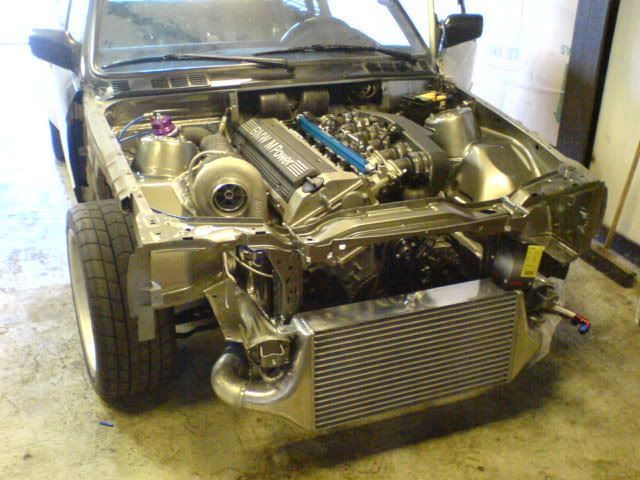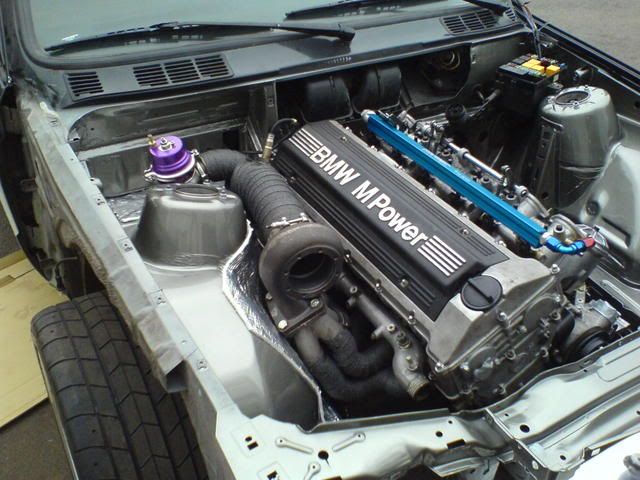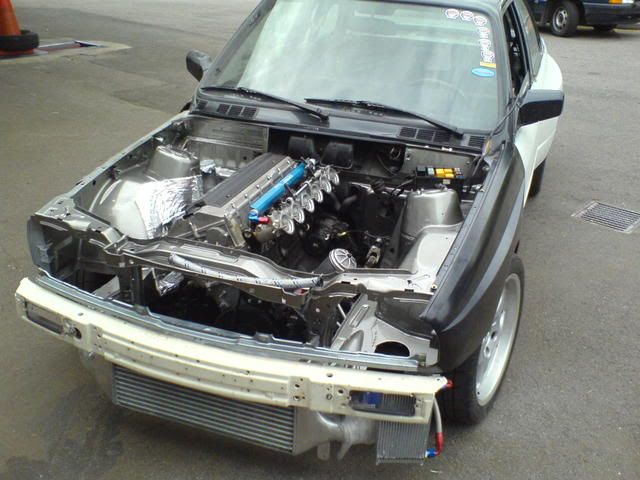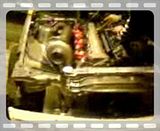As to the numbers that were recorded on Lucifer's Hammer during the April, 2005 dyno pulls.
1. Altitude will reduce horsepower at a rate of about 3.3% for every 1000 feet of elevation above sea level. The dyno is located at about 6200 ft ASL (suburban Denver). This means a power loss for
any NA motor of about 20.5% across the board. Further, additional adjustments can be made for air temperature and relative humidity, but the adjustment factors are quite small. IIRC, these get discussed in Bell's "Forced Induction Performance Tuning," pp 62-65.
2. On a properly configured dyno, the software asks for the input of altitude, air temp, RH before the runs commence.
3. The actual power delivered to the rollers is adjusted by the afore-mentioned factors, which are
multiplicative in nature, BTW.
Since the afore-mentioned factors tend to reduce delivered power, the compensation is to
divide the delivered power by the appropriate compensation factors to arrive at a value available under so-called "standard" conditions.
Example:
Sea level altitude = 100.0%. Less the altitude factor of .205
= .795. (6.2 x 3.3 = 20.46. 100.0-.205 = .795)
Air temp is usually taken at a standard 68 deg F. With air temp ~70 deg F, the adjustment factor is about .15%. Relative humidity is about in the same range.
So we have .795 x .9985 x .9985 = .7926.
Divide actual HP at the rollers by .7926 and the result is an
altitude-compensated value.
In my case, the horsepower at the eddy current armature within the Mustang dyno was around 567 and the
altitude-compensated power was 707.25. Which is about what I would see on a dyno pull done in Connecticut.
What this process does is allow runs taken under different conditions or locations to be compared on an apples-to-apples basis.
Lets assume for the moment a box-stock NA M30. The car gets taken to three different locations and gets put through the paces. A pull done on a 100 degree day in Phoenix can be accurately compared to one done on a 30-degree day in Denver to a 90-degree 100% humidity day in central Ohio. The actual readings off the rollers in these different locations will be different, chiefly due to altitude, but the mathematics permit doing the comparisons on a level playing field.
The issue of power loss at altitude gets a lot of people very exicted. Jay Kimball, who runs Mile High Performance where the runs were done on his Mustang dyno, does a lot of tuning work for serious drag iron which is being run at Bandimere Speedway--Mile High Nationals stuff. Bandimere is at about 6500 ft. Big Dogs come up from the LA area and panic when they find their motor suddenly lost 20-25% of its power. WTF?? The power loss has nothing to do with the engine . . . the air density is less, and so less power. The altitude is one reason the NHRA has a set of compensation tables to correct ETs for runs done here vs. those done at sea level.
A sidebar worth noting. Mile High performance is one of only a couple of shops in the Front Range certified by AirCare Colorado (our environazis) to perform dyno analyses on cars which fail Colorado's emissions tests. In these situations, the dyno is set up to run the car through the IM-240 tailpipe emissions profile. The exhaust is run through a 5-gas spectroscopic analysis. The results are then used to tune or repair the car to where it passes the emissions standards. This means that there is far too much at stake to play games with providing bogus dyno outputs. . . like criminal penalties.
For what it is worth, it is not unheard of for an unscrupulous dyno operator to alter the software settings or the resistance in the eddy current coils to yield incorrect power outputs.This isn't rare where a client has paid mucho $$ to the shop for a series of modifications and the shop can "prove" that a stated power output has been reached. But in Mile High's case, they have built a business on doing the job properly and the dyno is accurate.
When we were doing the tuning on LH, we had the car on the dyno for something in excess of 40 hours of actual dyno time over a period of several weeks. I lost count at somewhere over 300 pulls. These weren't necessarily short bursts. A lot of this was extended runs at a given set of values for timing, boost/vacuum, Ve, fuel delivery and so on. The purpose was to optimize the settings for use over as wide an operating range as I was likely to see, not just dial-it-in for-max-hp. Given that we were on and off the rollers (see comments re. emissions tuning above), there was a lot of care taken to be sure we had setups done correctly.
So the figures which I provided in the LH series and where I outlined to TCD and Russ C in a thread how the numbers came about are accurate. In other words, if you have a FI M30 in Lousiana which is indicating 300 hp at the rear wheels, bring it to Denver and it will show somewhere around 240, give or take.
To be noted here, these are rear wheel numbers. To adjust for power losses through the drivetrain, divide the rwhp by .84 for a manual transmission and about .8 to .78 for an automatic. This translates ito a 16% to 22% power loss between the flywheel and the ground. This will apply across the board to nearly all cars, not just BMW.
A few comments regarding Duke's statements about boost levels.
I discussed this at some length in my "Lucifer's Hammer" series, but here goes.
I achieved max hp at ~5700 rpm, and max torque at 4900. Both at 14.95 psi boost. This was done with a Turbonetics T66/T4 turbo. The T66 will push around 82-84# per min. air mass. When wound up closer to my 6300rpm redline, boost dropped off to around 12.5 psi, with a corresponding drop in hp.
The dropoff is due to the airmass going into "choke;" effectively going into a stall condition within the compressor. If you look at a compressor map, this is where the flow point has moved way to the right, away from the efficiency island. This is an indication that the compressor cannot meet the flow demand from the engine.
Further analysis on my motor indicated that
ideally I need a GT-42 or GT-45 capable of moving airmass in the 104-108# per min range to fully utilize the engine's capabilities.
The reason(s) that we didn't use the larger compressors were first, that doing so has major downsides in terms of lag and potentially running into "surge" at low engine speeds and loads. Second, the purpose with this motor is power and flexibility over a wide rpm range, NOT max power for quarter-mile applications. Thirdly, the physical size of a GT-4X series compressor has some limitations, given where the snail is located.
Looked at another way, we were trying to
maximize the area under both the hp and torque curves, not reach some arbitrary maximum hp or tq value. The fact that the power levels are reached at relatively low RPM has given the engine a huge load of day-to-day driveability and made it a lot less temperamental, as might be the case if everything is seen in the upper 5-10% of the rpm range.
Yeah, I'm still experiencing some tuning issues. When I come off idle the transitions could be a good deal smoother, and clutch engagement is hair-trigger. But nobody ever said this was a fix-it-and-forget-it deal.




